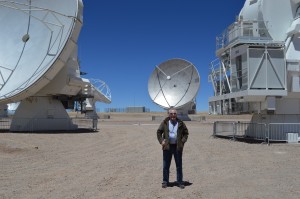First of all let me wish you all a Happy New Year. I hope that we will see real progress towards the realisation of the ILC in 2014, starting with the approval process in Japan and other countries. Now let me share a unique experience with you that provided me with a different perspective on how big science projects are organised in different scientific areas – and of how visiting scientists can be made comfortable under arduous conditions. In December I received an offer that I could just not refuse. It was to join a “visiting committee” to inspect the three sites of the European Southern Observatory (ESO) in Chile. The purpose of the committee was to independently assess the performance of ESO in providing top-class facilities for the users.
The oldest observatory is at La Silla. It lies about an hour north of Santiago by air and then another couple of hours to the mountain at 2600 metres altitude. There are a number of telescopes of different sizes owned by national laboratories with a few still run by ESO, although the policy of phasing out operations by 2020 means that there is no new investment. Nevertheless the scientific output is still prolific with more than 300 papers published per year, about half the number that is produced by its modern cousin at Paranal.
The Paranal site is another hour north by air to Antofagasta followed by a three-hour drive into the mountains to the Paranal observatory at 2635 metres altitude. There are four large 8.2-metre telescopes (the VLT), that can be operated independently or together as an interferometer. There are also a number of smaller telescopes that can be moved around on rails that always operate in interferometric mode. The hostel lodging the astronomers and operators, the Residencia, is spectacular. Since the relative humidity on the mountain can be as low as 4%, a very novel means of increasing the humidity inside has been implemented. There is an oasis of green inside the residence, with palm trees and a swimming pool which increases the humidity to about 40 % as well as offering relaxation to the residents, who generally do a 10-day stint on the mountain. The Residencia served as a backdrop for part of the 2008 James Bond film Quantum of Solace.
The final telescope site, ALMA, is even more spectacular. We accessed it after a 500-kilometre drive through the Atacama Desert. The Atacama Large Millimetre Array (ALMA) is a radio interferometer made of 66 12-metre and 7-metre dishes observing at millimetre and sub-millimetre wavelengths. It is a collaboration between the USA, Europe (through ESO) and Japan, sitting on a plateau at 5000 metres altitude with a base camp at 2900 metres. Before accessing the high site a medical examination is required and bottled oxygen is provided in case it is needed!
ALMA is now taking data while still being commissioned, a familiar situation to us working on particle accelerators. It has the usual problems of reliability during early operation but the scientific results are already spectacular. I am sure that we will hear much more of ALMA in the future.
This visit was a fascinating view of how another “big science” project works. Many of the problems are very familiar, the complexity of international collaboration and in the case of ALMA, the difficulty of commissioning a large and complex instrument under the pressure of producing scientific results.
It was an unforgettable experience, but now back to the day job!



Recent Comments